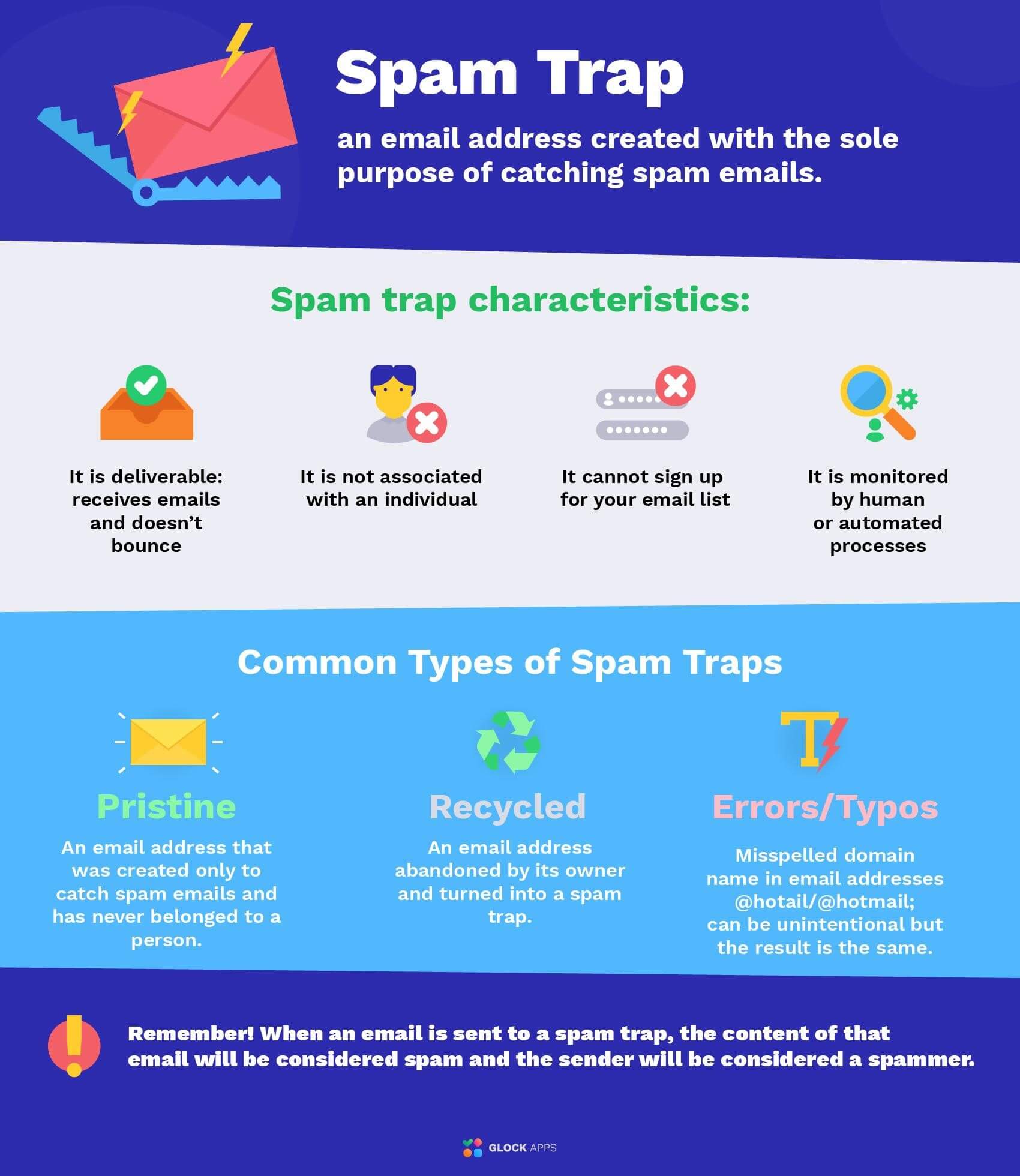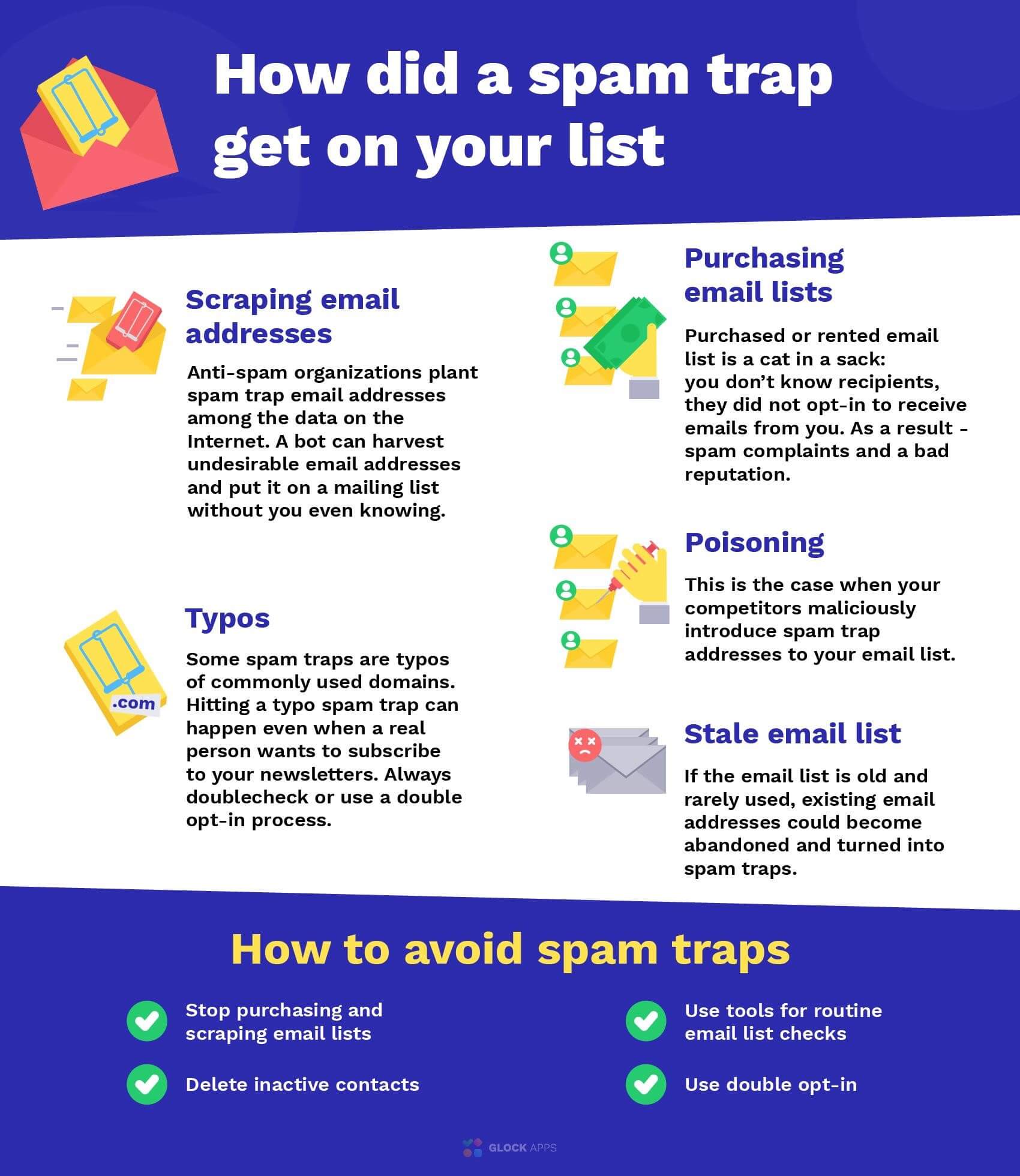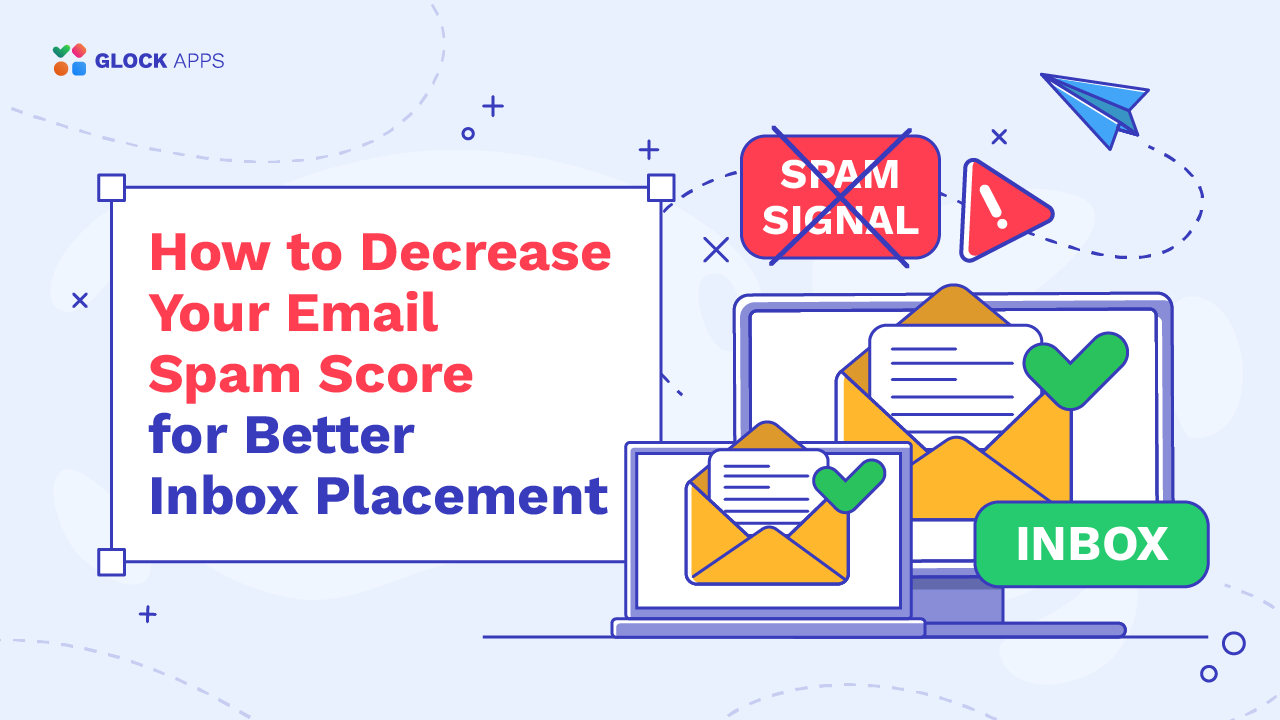Spam Traps 101: from Nightmare to Opportunity

Email getting into a spam trap is a nightmare for any email marketer. Unfortunately, it can happen even with the best of us. Afterwards, we keep wondering how a spam trap could get on our mailing list. Let’s solve this jigsaw puzzle step by step and by the end of this article everything will fall into place.
What is a Spam Trap?
A spam trap is an email address with certain characteristics, created with a sole purpose of catching spam emails.

Spam trap characteristics are:
- It is deliverable. Spam trap receives emails just like any other email address and it doesn’t bounce.
- It is not associated with an individual. Spam trap doesn’t belong to any particular human (as a personal email address).
- It cannot sign up for your email list. Since it is not owned by a person, there is no way for it to sign up to any email newsletters whatsoever.
- It is monitored by human or automated processes. Depending on the organization, there could be either a human or an automated program that sorts through spam emails.
When an email is sent to a spam trap, the content of that email will be considered spam and the sender will be considered a spammer.
Why Should You Care about Spam Traps?
For two reasons: firstly, even if your email behaviour is well intended, it does not mean you are immune to ending up with a spam trap on your list. Secondly, you might already be sending emails to spam traps without even knowing it, and that way posing a risk to your email deliverability. In both cases, you can’t protect yourself from what you don’t know about.
Who Creates Spam Traps?
There are different organizations that can create spam traps:
- ISPs – they create spam traps for user protection against malicious content;
- For-profit companies that sell spam filtering services. They use spam traps to identify incoming spam so they can help their clients filter it out;
- Non-profit organizations, like Spamhaus or SpamCop, that track spam and similar cyber threats;
- Individual anti-spam vigilantes – particularly people who fight against spammers.
People mistakenly believe some misconceptions about spam traps to be true:
1. You can hand-pick spam traps from the email list.
False. Oftentimes it is just impossible to visually detect a spam trap, because it looks like a regular email address.
2. You can obtain the list of spam traps.
When you hear that someone has obtained a crisp spam trap list – do not believe that. Spam traps change all the time, new ones appear, and there are millions of them.
Types of Spam Traps
Spam traps can have different forms. There are three commonly known types of spam traps: pristine, recycled and email address with typos.
Pristine
Pristine is the worst type of traps. It has never been somebody’s personal email address, and was created solely for catching spam emails. There is no way of justifying why this email address ended up on your mailing list. In most cases, pristine spam traps can be obtained as a result of scraping or purchasing of email lists. Hitting a pristine spam trap has the worst consequences for your email deliverability.
Recycled
Not as bad as pristine, but still highlights some of marketer’s bad email list management habits. Recycled spam traps used to be owned by persons. As it often happens, people change their email addresses, and abandon previous ones. After some time of inactivity, usually 12 months, providers can revive abandoned email addresses and turn it into a spam trap.
Typos
Email addresses with typos are also a popular way of catching spam messages. Most commonly, they have misspelled domain part of the address, for example @hotail instead of @hotmail, @gmal instead of @gmail, etc.
By now you can see that most spam trap hits happen due to a poor list management. Let’s figure out how exactly did a spam trap get on your list.
How Did a Spam Trap Get on Your List?

There are five ways you could have gotten a spam trap on your list:
- Scraping email addresses. Scraping means obtaining publicly shown email addresses on the web using a bot. In many countries, it is actually illegal, because basically what scraping does is it grabs email addresses randomly on the web without permission. Anti-spam organizations plant spam trap email addresses among the data on the Internet, and that’s where scraping bot trips over – it can simply harvest undesirable email addresses and put it on a mailing list without you even knowing.
- Purchasing email lists. It is a commonly known bad practice to buy email lists. When you purchase or rent an email list, you are simply buying a cat in a sack. You don’t know the recipients, they did not opt-in to receive emails from you, and apart from getting spam complaints you will risk your reputation greatly by hitting a spam trap. If this is not your case, don’t exclude other factors, like unscrupulous lead generation provider, or your predecessor.
- Stale email list. When you rarely send out email marketing campaigns, your email list gets stale. Among other problems, some of the email addresses may be turned into recycled spam traps. Even though you thought you were sending emails to your clients, letters will be hitting spam traps.
- Typos. As previously said, some spam traps are typos of commonly used domains. Hitting a typo spam trap can happen even when a real person wants to subscribe to your newsletters, but types @gnail instead of @gmail, it can keystroke a spam trap.
- Poisoning. This is a very unfortunate situation, but in highly competitive environments, it happens. This is the case when your competitors maliciously introduce spam trap addresses to your email list. This is not an everyday scenario, but keep in mind that it is a possibility.
Consequences of Getting into a Spam Trap
Hitting a spam trap will damage your reputation, and your deliverability will decrease. Your ISP may restrain you from sending as many emails, or you even might get blocked. You can also find yourself blacklisted. As your sender reputation will decrease, you will face higher bounce rates and junk folder placement.
Read: IP Blacklist Removal – How To Fix a Blacklisted IP Address
No matter what type of spam trap you hit, you will face penalties. As a sender you will be considered either a spammer or a sloppy sender with poor email list management.
How to Remove a Spam Trap?
You have spam traps on your list. Now what? A spam trap is a certain indicator that can be leveraged. It is an incredibly valuable tool for the entire email marketing ecosystem, but it doesn’t mean that you, as an email marketer, are not struggling with it.
When you find a rotten apple in a bucket of apples, you want to know how it got there. Maybe you were picking apples from the ground instead of plucking them from the trees. Ask yourself: what is this spam trap telling me? How did it get on my list? What should I do differently?
Here’s what you can do:
- Trace back mailing list history. Has anyone made any changes to it recently? Maybe some data has been imported recently, or have you started mailing to older accounts?
- Segment your list. Segmenting often helps to narrow down the cluster with a problem.
- Talk to an expert. Ask a professional to help you get to the root of the problem, and figure out where the problem comes from;
- Blacklist removal. Once you identify and get rid of a problem, switch to blacklist removal process. It is important to deal with this before sending out a new email marketing campaign.
How to Avoid Spam Traps
Spam traps can become a disaster but it is also an opportunity to enhance your practices.
Here is the list of actionable tips to stay away from spam traps:
- Stop purchasing and scraping email lists. This is the shortcut to a spam trap. Instead, grow your email list organically. It will take more time and effort but will be well worth it in the long run. You will have a list of real people who are interested in your product/service;
- Delete inactive contacts. To avoid recycled spam traps it is necessary to clean your email list and get rid of inactive and old email addresses that could potentially be converted into a spam trap;
- Use double opt-in. When you send a confirmation letter, you automatically clean your list of misspelled and invalid email addresses. It takes additional action from your subscribers, but it is an important defense line for your email list.
- Routine checks. Use tools to routinely check your email list for spam traps so that you would have a squeaky-clean email list before sending out your next email marketing campaign. Thoroughly go through all new data at the point of collection.
What Good Can Come from Recycled Spam Traps?
We’ve talked about all the harm spam traps can do, but is there any tangible benefit you can extract out of them? If we’re talking about recycled spam traps, then yes.
Old, abandoned and recycled email addresses can be effectively used on Facebook for creating lookalike audiences. Since recycled spam traps once were your customers, there might be existing Facebook profiles tied to them. Make the list in the csv or txt format, upload it to Facebook in your Ads Manager, and create a custom audience. After you’re finished, you can easily make a lookalike audience based on profiles of people who once subscribed to your emails.
Lookalike audiences can help you grow your business and advertise to people similar to your audience. And then delete these recycled spam trap addresses from your email list.
Takeaways
Spam traps give a horrible headache to email marketers but they are also an opportunity to enhance existing processes and implement best practices into email marketing.
Spam traps may look just like any other email, but it does not belong to a particular person and it can’t subscribe to your emails. It can either be scraped, obtained with a purchased email list, or planted (happens rarely).
There are three types of spam traps: pristine, recycled, and email address with a typo. The most undesirable is getting in a pristine spam trap, in which case your IP will be blocked right away.
To avoid spam traps that may land you in the spam folder, you must follow best practices: never scrape or purchase email lists, delete old, inactive email addresses and hard bounces, use double opt-in, and conduct routine email list checks.



